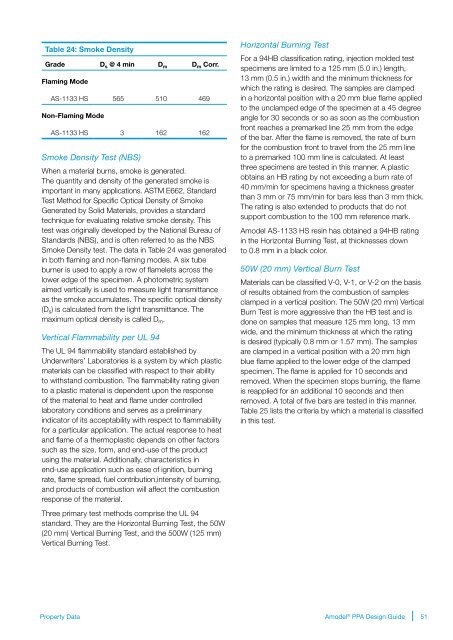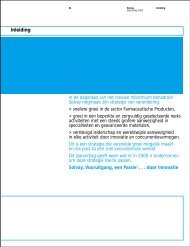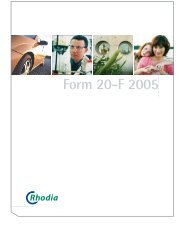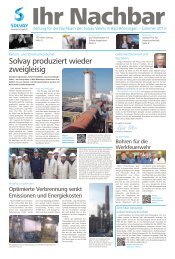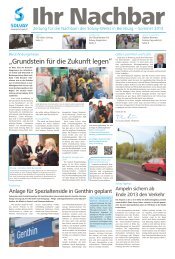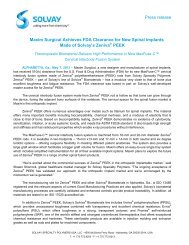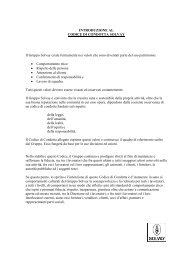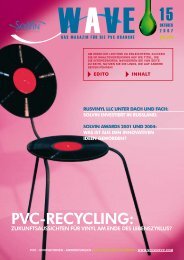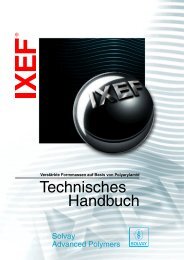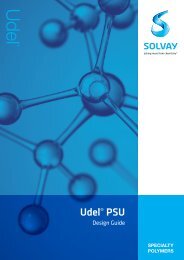Design Guide - Solvay Plastics
Design Guide - Solvay Plastics
Design Guide - Solvay Plastics
You also want an ePaper? Increase the reach of your titles
YUMPU automatically turns print PDFs into web optimized ePapers that Google loves.
Table 24: Smoke Density<br />
Grade D s @ 4 min D m D m Corr.<br />
Flaming Mode<br />
AS-1133 HS 565 510 469<br />
Non-Flaming Mode<br />
AS-1133 HS 3 162 162<br />
Smoke Density Test (NBS)<br />
When a material burns, smoke is generated.<br />
The quantity and density of the generated smoke is<br />
important in many applications. ASTM E662, Standard<br />
Test Method for Specific Optical Density of Smoke<br />
Generated by Solid Materials, provides a standard<br />
technique for evaluating relative smoke density. This<br />
test was originally developed by the National Bureau of<br />
Standards (NBS), and is often referred to as the NBS<br />
Smoke Density test. The data in Table 24 was generated<br />
in both flaming and non-flaming modes. A six tube<br />
burner is used to apply a row of flamelets across the<br />
lower edge of the specimen. A photometric system<br />
aimed vertically is used to measure light transmittance<br />
as the smoke accumulates. The specific optical density<br />
(D s ) is calculated from the light transmittance. The<br />
maximum optical density is called D m .<br />
Vertical Flammability per UL 94<br />
The UL 94 flammability standard established by<br />
Underwriters’ Laboratories is a system by which plastic<br />
materials can be classified with respect to their ability<br />
to withstand combustion. The flammability rating given<br />
to a plastic material is dependent upon the response<br />
of the material to heat and flame under controlled<br />
laboratory conditions and serves as a preliminary<br />
indicator of its acceptability with respect to flammability<br />
for a particular application. The actual response to heat<br />
and flame of a thermoplastic depends on other factors<br />
such as the size, form, and end-use of the product<br />
using the material. Additionally, characteristics in<br />
end-use application such as ease of ignition, burning<br />
rate, flame spread, fuel contribution,intensity of burning,<br />
and products of combustion will affect the combustion<br />
response of the material.<br />
Three primary test methods comprise the UL 94<br />
standard. They are the Horizontal Burning Test, the 50W<br />
(20 mm) Vertical Burning Test, and the 500W (125 mm)<br />
Vertical Burning Test.<br />
Horizontal Burning Test<br />
For a 94HB classification rating, injection molded test<br />
specimens are limited to a 125 mm (5.0 in.) length,<br />
13 mm (0.5 in.) width and the minimum thickness for<br />
which the rating is desired. The samples are clamped<br />
in a horizontal position with a 20 mm blue flame applied<br />
to the unclamped edge of the specimen at a 45 degree<br />
angle for 30 seconds or so as soon as the combustion<br />
front reaches a premarked line 25 mm from the edge<br />
of the bar. After the flame is removed, the rate of burn<br />
for the combustion front to travel from the 25 mm line<br />
to a premarked 100 mm line is calculated. At least<br />
three specimens are tested in this manner. A plastic<br />
obtains an HB rating by not exceeding a burn rate of<br />
40 mm/min for specimens having a thickness greater<br />
than 3 mm or 75 mm/min for bars less than 3 mm thick.<br />
The rating is also extended to products that do not<br />
support combustion to the 100 mm reference mark.<br />
Amodel AS-1133 HS resin has obtained a 94HB rating<br />
in the Horizontal Burning Test, at thicknesses down<br />
to 0.8 mm in a black color.<br />
50W (20 mm) Vertical Burn Test<br />
Materials can be classified V-0, V-1, or V-2 on the basis<br />
of results obtained from the combustion of samples<br />
clamped in a vertical position. The 50W (20 mm) Vertical<br />
Burn Test is more aggressive than the HB test and is<br />
done on samples that measure 125 mm long, 13 mm<br />
wide, and the minimum thickness at which the rating<br />
is desired (typically 0.8 mm or 1.57 mm). The samples<br />
are clamped in a vertical position with a 20 mm high<br />
blue flame applied to the lower edge of the clamped<br />
specimen. The flame is applied for 10 seconds and<br />
removed. When the specimen stops burning, the flame<br />
is reapplied for an additional 10 seconds and then<br />
removed. A total of five bars are tested in this manner.<br />
Table 25 lists the criteria by which a material is classified<br />
in this test.<br />
Property Data<br />
Amodel ® PPA <strong>Design</strong> <strong>Guide</strong><br />
51


